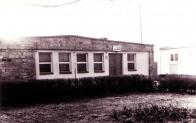Yesterday
Folk and Artistic Industry Cooperative „Świętokrzyskie Weaving” in Bodzentyn was established thanks to District Cooperative Peasant Mutual Aid Society in Bodzentyn.
Weaving machine was bought in 1946 in Wzdół Rządowy. The decision to sell it was made in 1948 and for the received money a wind mill was bought. An engineer Antoni Waciński, then headmaster of State Pedagogical High School, well known community worker, put forward a proposal to re-buy the machine by District Cooperative(DC) and that was the beginning of the future weaving mill.
In 1949 DC board bought another 3 weaving machines from Szwajdler company from Cracow.
In January 1950 Szwajdler offered to lead a folk weaving course in District Cooperative in Bodzentyn and he put forward an idea of linen, homespun and regional craft production. 36 women graduated the course under the leading of Antoni Szwajdler and at the end of the course there was an exhibition of made fabric. To improve skills second 3-month weaving course was organized but not under the protection of DC but Folk and Artistic Industry Cooperative in Bodzentyn.
On the 25th of March 1950 general founding meeting took place and weaving mill was formally taken under the attention of Cepelia (The Central Guild of Folk, Art and Crafts) and became independent under the name „Świętokrzyskie Weaving, Folk and Artistic Industry Cooperative in Bodzentyn”.
„Świętokrzyskie Weaving” was legally registered in District Court in Kielce on the 16th of September 1950.
At first weaving mill was located in a barrack on Wesoła Street, where later on a kindergarten was located. Next it moved to now demolished building on the corner of Upper Square and Czysta Street. Between 1951-1962 it was placed in a multi-storey building on Upper Square, where later DC offices were set, and in January 1963 it moved to its own building built on Suchedniowska Street for the sum of 3million zlotys.
Those buildings were built on a plot belonging to State Fund of Land covering over 5000 m2.
In later period in 1972-1974 a social and cultural building and a concert hall with a scene were additionally built near a shop floor and utility room and office space.
Like in any other cooperative in „Świętokrzyskie Weaving” annual general meeting, which took place every spring, had the highest power, according to a statute. It chose a board of trustees, which appointed a board to lead works of the cooperative. The board of trustees had 8 people, which appointed 3-people board. Andrzej Telka was the longest incumbent chairman.
The number of employees increased all the time for example in 1955 45 people worked, including 36 full time workers and 9 out-workers, in 1980 the firm hired 162 people, including 132 full time workers and 30 out workers. They were mainly women, men constituted 10% of the employees.
Every worker of the weaving mill should have been at the same time a shareholder member of cooperative and was taken in by the board of trustees only after a year of work.
The material base was buildings, machines, weaving crafts and other devices essential in the production. In order to increase production and employment since 1972 the cooperative rented rooms from Władysław Kręcisz from Wzdół Wiączka. 21 female workers manufactured tablecloths, doilies and other linen fabrics. 23 female workers manufactured woolen and linen fabrics in Bodzentyn, in Eugeniusz Michta’s place.
Wool, flax and cotton were the basic materials used in the production. At first cooperative had difficulties gaining the material thus workers had to take care of wool purchase that should have been washed, dried and then spun. Later on the material was imported among other things from Pabianice and Zawiercie. Wool yarn was used to make kilims, aprons, runners, tapestries; flax yarn for table cloths; cotton yarn for pillows, table cloths. The weaving mill received that material in strips and bobbins originally in white colour. Dyed yarn was used for production, and because cooperative didn’t have a dye works it was dyed in „Ład” cooperative in Warsaw.
The production process consisted of a lot of stages and resulted in a ready product. Trimmed fabric, attached proper label with information about a product, its material, name of a product, its price, measurements- it all went to a store-house of ready products. There was a good market for the products from the weaving mill not only in big cities in Poland (Kielce, Cracow, Warsaw, Lublin, Lodz, Poznań, Gdańsk, Wroclaw) but also abroad. „Świętokrzyskie Weaving” supplied not only domestic market but also exported its products to socialist countries in a first place but also to other countries of Europe such as: Holland, Belgium, Sweden, West Germany and even to USA, Canada and Japan..
In 1965 a singing and dancing group „Przepióreczka” was established by the weaving mill. There were senior group, junior one and a folk band. Those bands safeguarded old regional tradition. Due to economic and political changes in the country in the end of the 80s and the beginning of 90s the cooperative got into financial trouble and as a result it bankrupted in 1993 and next it was sold in auction.
The effects of the functioning of the cooperative are as following:
- Revival and promotion of Świętokrzyskie folklore;
- Employment for over 160 people, mostly women;
- Making Bodzentyn and Świętokrzyskie region famous;
- Stimulating cultural life by establishing „Przepióreczka” group and a folk band.
Stefan Rachtan,
The Chairman of Friends of Bodzentyn Society









 projekt współfinansowany w ramach programu
projekt współfinansowany w ramach programu